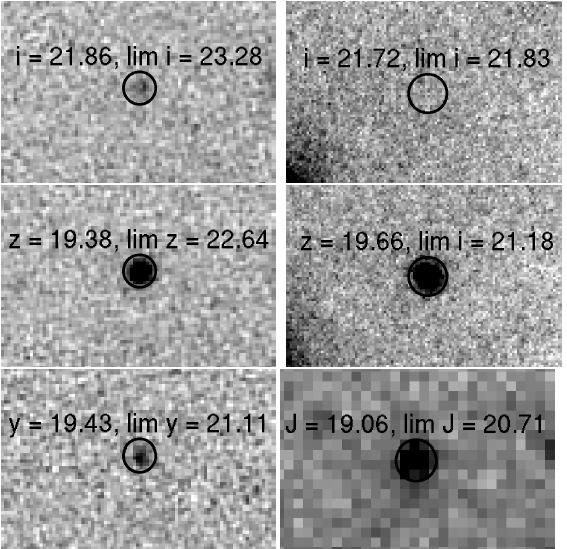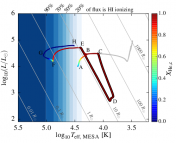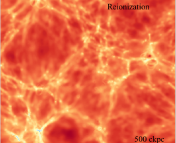Title: Strong Lyman continuum emitting galaxies show intense C IV λ1550 emission
Authors: D. Schaerer, Y. I. Izotov, et al.
First Author’s Institution: Observatoire de Genève / Institut de Recherche en Astrophysique et Planétologie
Status: Published in Astronomy and Astrophysics [open access]

This guest post was written by Riley Owens, a postbaccalaureate researcher between groups at the American University of Sharjah, the University of Cincinnati, and West Virginia University. His research interests are broad, but focus upon the impact of massive stars throughout time. In his free time, he enjoys playing with his dog and long phone calls with friends.
Introduction
In the history of our universe, the period of reionization represents a remaining gap in our knowledge. During this time, the very first massive stars and quasars formed out of the then-neutral content of the universe and ionized this material.
But how did that ionizing radiation (called Lyman continuum; LyC) escape those galaxies? Strangely, LyC doesn’t escape more recent galaxies enough to explain how ionized our universe appears. This suggests a significant evolution in galaxies between now and reionization.
Unfortunately, directly observing LyC from reionization is serendipitous at best, since the increasing neutrality of the universe at higher redshifts rapidly attenuates LyC.One way astronomers are trying to resolve this dilemma is by observing the LyC emitters which do exist in the nearer universe, in order to identify quantities which correlate with LyC escape. Understanding the astrophysics of these quantities helps to explain the conditions leading to LyC escape, but also what astronomers could look for in reionization galaxies to infer how much LyC escapes from them and how.
Observations
In today’s paper, astronomers observed the ultraviolet (UV) emission lines of low-redshift star-forming galaxies with the Hubble Space Telescope’s Space Telescope Imaging Spectrograph instrument. Previous surveys identified these galaxies as LyC emitters covering a range of LyC escape strengths. The UV wavelengths contain many features which can serve as important probes for the interstellar medium (ISM) in a galaxy, which LyC photons must navigate to escape the source galaxy. Connecting UV features and LyC escape is critical because the James Webb Space Telescope and other upcoming telescopes will push boundaries for UV astrophysics in the high-redshift universe (including reionization).
The observations detect many emission lines (see Figure 1), but the authors focus on carbon and helium emission. Specifically, they detect the [C III] 1907 Å, C III] 1909 Å (where the brackets indicate their forbidden and semiforbidden nature) doublet (though the two are not resolved) in all the galaxies, C IV 1548, 1550 Å doublet (also unresolved) in 5/8, and He II 1640 Å in 5/8. Neither of the doublets show a clear correlation in strength with the LyC escape of the galaxies. The [C III], C III] emission strength is unremarkable compared to other low-redshift galaxies, but the C IV emission of a majority of the strong leakers (where >10% of LyC escapes) is among the strongest by the same comparison. Notably, though, the strongest C IV emitter (and of any galaxy at z < 0.4) is the weakest LyC leaker. The strong leakers also show powerful helium emission for star-forming galaxies. Though the causes of a He II 1640 Å emission line are not entirely clear, it is typically posited as closely connected to massive stars, which is suggestive of what produces LyC in the galaxies and how it escapes.
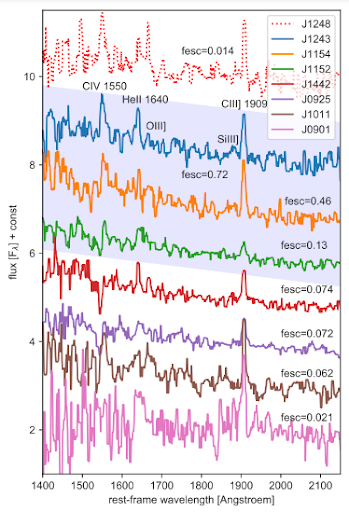
Though neither [C III], C III] or C IV emission clearly correlates with LyC escape, a new quantity might. The authors suggest the truly distinguishing characteristic of the strong leakers is the ratio between the two; what they define as C43 ( = C IV / ( [C III], C III] ) ). Indeed, the strong leakers seem to correlate with a high C43 and the weak leakers with a low C43 (see Figure 2). This motivated them to suggest C43 ≳ 0.75 as an identifier for strong LyC leakers. An advantage of this quantity is that C IV is a resonant emission line, meaning it is more sensitive to gas between us and the source, similar to how LyC is very sensitive to neutral hydrogen gas.
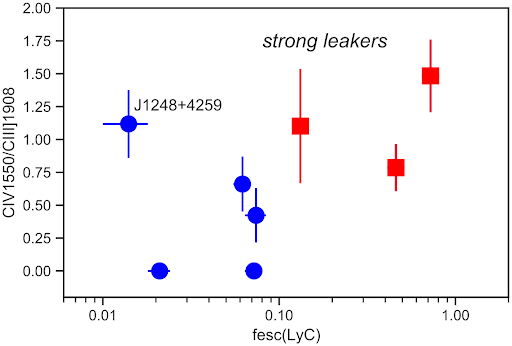
One galaxy in the sample is clearly out of line: J1248+4259 (see Figure 2), since it has a C43 comparable to the strong leakers, but is the weakest LyC leaker. However, this galaxy shows multiple other indirect signatures of strong LyC escape. Because we can only directly measure LyC escape along the direction of our perspective into the galaxy, it could appear to be much lower than a ‘global’ or volume-averaged LyC escape, which might place it in the strong leaker camp.
Causes
Modeling emission line strengths is difficult because of its dependence on many factors. A complete description calls for thorough photoionization models. Models for star-forming galaxies of similar metallicities predict upper bounds on carbon emission line strengths similar to the strongest observed in the sample. Similarly, the authors use a simple model for the He II 1640 Å emission line to demonstrate the observed strengths are feasible with a high production of helium-ionizing photons. Put together, these indicate exotic conditions are not necessary to explain the characteristics of the strong leakers. Because galaxies like these may be the best analogues to the galaxies responsible for reionization, this has important implications for the necessary conditions in those earlier galaxies. The authors and other scientists are continuing to investigate the utility of their new diagnostic and the connection between strong CIV emitters and LyC leakers.

